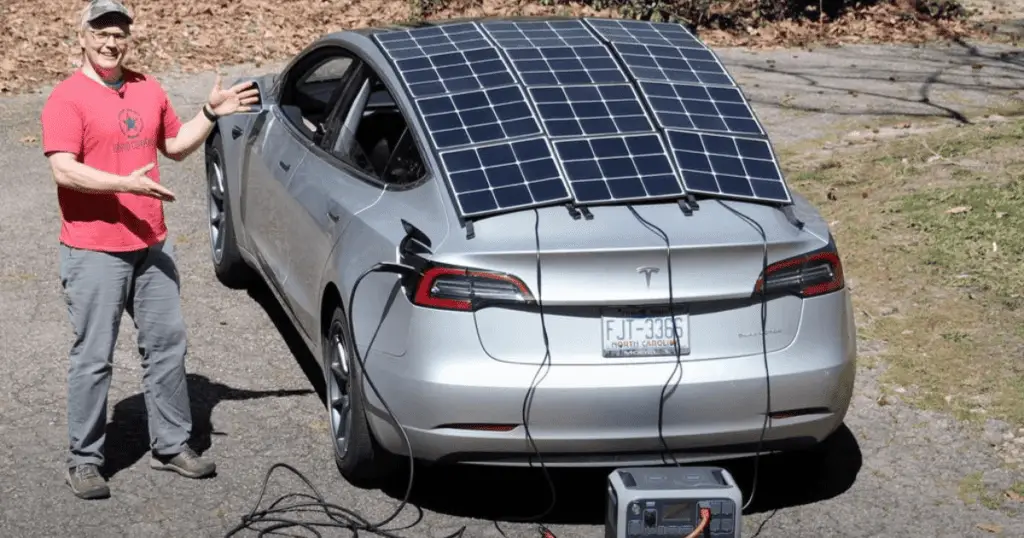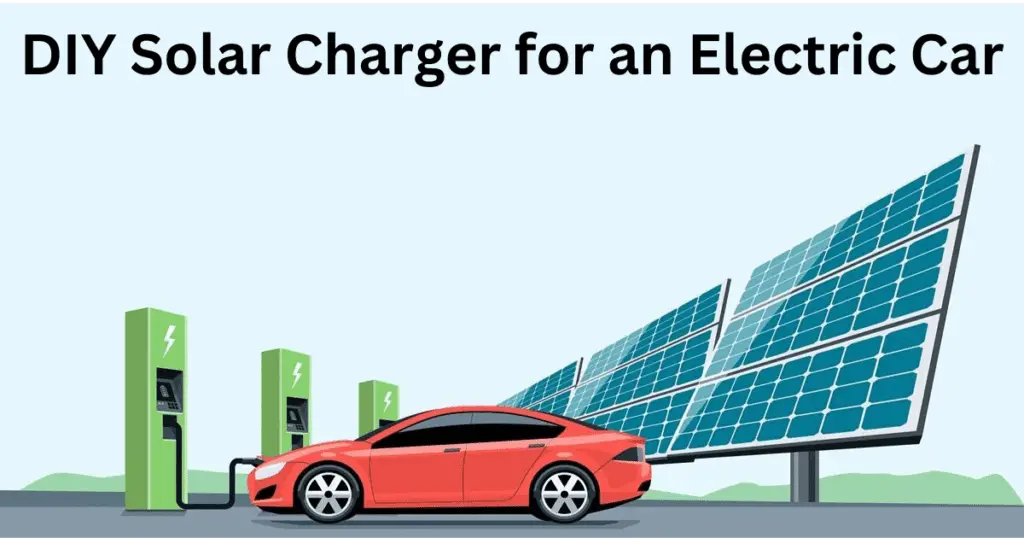In our ever-changing global landscape, the imperative shift toward sustainable energy sources has grown far beyond the realm of mere luxury. Electric vehicles have taken center stage in this transformative journey, providing an environmentally conscious and beneficial mode of transportation.
Electric vehicles are vulnerable to environmental consequences because their reliance on the electricity grid does not ensure a consistent source of clean energy. This in-depth analysis begins with an investigation of a captivating solution that perfectly aligns with our vision for a greener future: the DIY Solar Charger designed for Electric Vehicles.
1. What is a DIY Solar Charger for an Electric Car?
A DIY solar charger for an electric car is a homemade setup intended to capture sunlight using solar panels. The aim is to convert this solar energy into usable electricity, suitable for charging the battery of an electric vehicle.
This system typically involves assembling solar panels, a charge controller, and sometimes an inverter to manage and transform the captured solar power into a form compatible with the car’s charging mechanism. The ultimate goal is to enable the car to charge using clean, renewable solar energy, reducing reliance on traditional grid electricity sources.
2. Benefits of a DIY Solar Charger for an Electric Car
Positive Environmental Impact
Embracing a self-made solar charger for your electric vehicle marks a substantial leap in lessening your environmental impact. Utilizing renewable solar energy rather than traditional grid electricity significantly contributes to mitigating greenhouse gas emissions and fostering a more pristine ecosystem.
Solar chargers distinctly showcase a remarkably reduced carbon footprint in contrast to power sources reliant on fossil fuels, reaping rewards for both your financial well-being and the welfare of the planet.
Cost-Efficiency
A standout benefit of integrating a DIY solar charger for an electric vehicle is the potential for considerable savings over the long haul. Despite the upfront investment being significant, solar panels boast a lengthy lifespan and require minimal upkeep.
As time progresses, the electricity generated from solar power has the potential to balance out your charging costs, leading to substantial financial advantages.
Energy Autonomy
A DIY solar charger bestows upon you a degree of energy independence. You are no longer solely reliant on the grid, which proves especially advantageous during power outages or in remote locations where grid access is limited. The capability to generate your electricity imparts a sense of control and self-reliance.
Convenience
Powering your electric vehicle at home gains added convenience with a DIY solar charger. You hold the freedom to arrange your charging sessions to align with the sunniest periods of the day, ensuring your vehicle remains primed whenever required. This ease is further amplified by smartphone apps and intelligent charging systems that grant you the ability to remotely oversee and regulate your charger.
3. Components and Materials
Constructing your DIY solar charger for an electric car necessitates a range of components and materials. Let’s delve into the specifics of each of these elements.
Solar Panels
Solar panels serve as the core of your solar charger, capturing sunlight and transforming it into electricity. When selecting solar panels, take into account factors such as efficiency, durability, and the quantity of panels required to meet your charging demands. Premium solar panels often come with warranties and boast a lengthy operational lifespan.
Charge Regulator
A charge regulator assumes a pivotal role in orchestrating the flow of electricity from the solar panels to the batteries, mitigating the risk of overcharging and ensuring the batteries receive an optimal charge. It is imperative to meticulously select a charge regulator that harmonizes with the voltage and capacity of your system.
Electricity Converter
An electricity converter holds an indispensable position, as it transmutes the direct current (DC) electricity, generated by the solar panels, into alternating current (AC) electricity that is compatible with your electric car. It is crucial to verify that the electricity converter can effectively manage the power output of your solar panels and incorporates essential safety protocols.
Energy Storage Units
Energy storage units stand as a paramount element for accumulating surplus solar energy, ready for utilization when sunlight becomes scarce, such as during nighttime or on cloudy days. Lithium-ion batteries, esteemed for their remarkable energy density and resilience, remain a favored choice for this purpose.
Mounting and Wiring
Properly mounting your solar panels is essential to maximize their exposure to sunlight. Additionally, the wiring between all components must be secure and follow the correct electrical standards to ensure safety and efficiency.


4. Installation Process
Now, let’s explore the installation process for your DIY solar charger for an electric car.
Selection of the Optimal Site and Positioning
Selecting the most suitable location for your solar panels is of paramount importance. It is imperative to position them in areas where they can harness the maximum sunlight throughout the day. Ideally, south-facing rooftops or unobstructed open spaces devoid of shading offer the perfect placement.
Moreover, the orientation, or angle, of the panels should be meticulously adjusted to correspond with your specific geographical location, ensuring the utmost solar exposure is attained.
Mounting Solar Panels
Ensure your solar panels are securely mounted, following the manufacturer’s guidelines. Proper mounting not only ensures safety but also increases the longevity and efficiency of the panels. It’s essential to use the correct mounting hardware and consider factors like wind load and weight.
Wiring and Connection
Wiring the components together requires precision to prevent energy losses and ensure safety. The wiring must be properly grounded, and you should follow local electrical codes. It’s advisable to consult with a professional electrician or solar installer for this step, especially if you’re not experienced with electrical work.
5. Performance and Efficiency
Factors Affecting Efficiency
The efficiency of your DIY solar charger is determined by a variety of factors, including the quality of your solar panels, the angle and positioning of the panels, and the amount of sunshine available in your specific area. Consistent cleaning and maintenance of the panels is also required to ensure their best operation.
Monitoring and Maintenance
Monitoring the performance of your solar charger is crucial to ensure it continues to function optimally. Many solar systems come with monitoring tools that allow you to track energy production and identify any issues. Routine maintenance, such as cleaning the panels and checking connections, is necessary to extend the life of your system.
6. Real-World Applications
Use Cases
DIY solar chargers for an electric cars have found applications in various scenarios. They are commonly used by environmentally conscious homeowners who want to power their electric vehicles with clean energy.
Additionally, businesses and public charging stations are beginning to integrate solar chargers into their infrastructure to offer green charging options to customers.
Success Stories
Numerous success stories showcase the positive impact of DIY solar chargers for an electric cars. One such example is the case of a family in California who, by harnessing solar energy for their electric vehicle, managed to reduce their annual energy costs by 50%. These stories underscore the feasibility and benefits of solar charging solutions.
Conclusion
In conclusion, the DIY solar chargers designed for electric cars mark a significant stride in promoting sustainability. Through the utilization of solar energy to charge your electric vehicle, you actively participate in environmental preservation, realize substantial financial benefits, attain energy self-sufficiency, and relish the ease of home-based charging. In a world progressively advancing toward a more eco-conscious future, these solar chargers offer an attainable and pragmatic avenue for individuals and businesses alike to diminish their impact on the environment.
Frequently Asked Questions (FAQs)
Q1. What is the average expenditure associated with establishing a do-it-yourself solar charging system for an electric automobile?
The average cost linked to setting up a DIY solar charging system for an electric car can vary based on factors like the system’s size, component quality, and installation complexity. Generally, this expense might range between $2,000 to $5,000 initially. However, it’s essential to note that these costs may decrease over time as you focus on enhancing energy efficiency and adopting sustainable practices in managing resources.
Q2. How much sunlight is requisite for optimal effectiveness of a DIY solar charger?
The efficiency of your DIY solar charger is contingent upon the volume of sunlight your location receives. For optimal performance, it is advisable to position the panels in an area exposed to at least 4-6 hours of direct sunlight daily, ensuring proficient charging.
Q3. Is it feasible to complete the installation of a DIY solar charger for an electric car independently, or is professional assistance necessary?
While it is possible to undertake the installation of a DIY solar charger on your own, it is advisable to consider professional assistance, particularly for tasks related to electrical components and wiring. Engaging a licensed electrician or a qualified solar installer can ensure safety and adherence to local regulations.
Q4. Do DIY solar chargers work with all electric car models?
DIY solar chargers can be adapted to work with most electric car models, but compatibility may vary. Ensure that your system’s voltage and capacity match your electric car’s requirements. Many electric car manufacturers also offer guidance on solar charging solutions.
Q5. What is the expected lifespan of solar panels in a DIY solar charger system?
Solar panels of exceptional quality possess the potential for an operational life span extending well beyond 25 years. Opting for renowned panels accompanied by robust warranties is of paramount significance in ensuring their sustained endurance and optimal functionality.
Q6. Are there government incentives or rebates for DIY solar charger installations?
Government incentives and rebates for solar installations vary by location. Check with your local and national government agencies to find out if you qualify for any financial incentives or tax credits for your DIY solar charger project.

